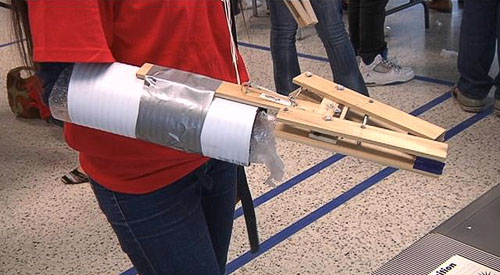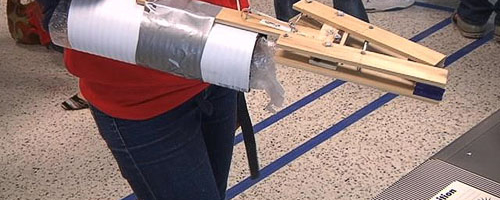The first film I vividly recall watching is the original Star Wars. Every Sunday as a kid I’d come home from church and watch it with my parents. At some point they introduced me to the sequel, The Empire Strikes Back. I was enthralled with the film up until the scene where Darth Vader cuts Luke’s hand off. If that tidbit is a spoiler for anyone, I apologize (but also, it’s 2013 and if you haven’t seen Star Wars then you should reevaluate your life).
A new prosthetic

The first film I vividly recall watching is the original Star Wars. Every Sunday as a kid I’d come home from church and watch it with my parents. At some point they introduced me to the sequel, The Empire Strikes Back. I was enthralled with the film up until the scene where Darth Vader cuts Luke’s hand off. If that tidbit is a spoiler for anyone, I apologize (but also, it’s 2013 and if you haven’t seen Star Wars then you should reevaluate your life).
Luke having his arm amputated disturbed the young me more than anything I’d seen up to that point. I couldn’t watch the film for years because of how much it affected me—not so much the actual amputation but the way Luke’s hand was replaced with a robotic prosthetic. Three-years-old me became convinced I was a robot made up of circuitry and fake skin. Now I’m older and (a little bit) wiser, and almost 100 percent sure I’m not a robot.
There is a point to this anecdote, I swear. Earlier this month, Portland State played host to around 250 middle and high school students, all vying to be chosen as creator of a new prosthetic limb. The main focus of the project was to create a new limb that would eventually be sent to “help children in developing countries who’ve lost arms to land mine accidents.”
Students were divided into 80 teams and had been working on the project for the last eight months. They showed their projects on Friday, May 10, as part of Oregon MESA Day.
MESA—Mathematics Engineering Science Achievement—is part of PSU’s Maseeh College of Engineering and Computer Science’s outreach program. By partnering with local organizations like Intel and Luma Lighting, Oregon MESA’s goal is to engage sixth- through 12th-grade students in projects that will help prepare them for college and to pursue degrees in the science, technology, math or engineering fields.
Not only does this project have good, sound, non-dark-side intentions, it’s also doing a lot for students and the community. There is a 100 percent graduation rate among students who participate in the program. According to Suzanne Stevens, a writer for Portland Business Journal, that’s double the normal graduation rate for the rest of Portland Public Schools (the rate is “about 35 percent for low-income and minority students”).
Whatever the outcome of these projects is, the program is being funded and the students are able to work with professionals in their given discipline and get a taste for what kind of work the jobs entail. This also aids in building humanitarian mindsets, which contributes to creating sustainable technologies and relationships with other countries.
This is a really cool thing, and it’s awesome that so many young adults are getting the chance to work on a project of this magnitude. It’s also nice that PSU is involved. Good job, PSU. But how about taking it further?
Instead of just limiting it to middle and high school kids, why not create something for elementary school children? I mean, I thought there was a major possibility of me being a robot until I was, like, 5. I’m pretty sure most parents don’t want that for their children.
If this were introduced at an even younger age (just something like it, with less pressure, of course), interest in science and technology could be fostered and encouraged in children for a much longer span of time. If that were to happen there might be higher graduation rates across the board, not just for those students taking part in a specific program. And that’s part of what school is all about, right?
For some reason, the results of this year’s project haven’t been published, so there’s not yet a way of telling whether the students created the next prosthetic or not—but I’m sure they did. In a program that’s funded by Intel with working professionals leading the way, these kids are off to a great start in the science and technology fields.
And, who knows, maybe in a few years that robotic hand Luke Skywalker had back in 1980 will be a reality.






Hi, great project! I was wondering what supplies you used to make this. Thank you.